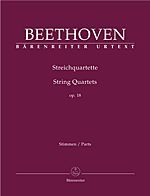Beethoven String Quartets op. 18 |
| The internationally renowned Beethoven scholar has turned his attention to a set of chamber
musical crown jewels; Beethoven’s important opus 18 string quartets. The new Bärenreiter publication is not based on a reprint of the first edition parts, but makes use of a manuscript set of parts with some corrections in Beethoven’s hand which turned up in the 1980s. The new edition clarifies many ambiguities in slurring and dynamics as well as numerous wrong notes in the inner voices. It offers performers a fully reliable music text impeccably laid out so as to meet the needs of performers. The result of Del Mar’s work can be summed up with the words; “clarity”, “transparency”, ”excellence”. - Bärenreiter quality Urtext - Critical Commentary with facsimiles - Meticulously laid out performance parts “On a firmer footing: The most reliable editions are mainly found in the Complete Editions. But even volumes of the Complete Editions lose their up-to-dateness as soon as important sources emerge which the editor did not know. So it is with the volume of Beethoven’s six string quartets Op. 18, written between 1798 and 1800, which was published in the Beethoven Complete Edition in 1962. For several decades, this was the standard edition of these quartets. But it is based on an inaccurate source – the original printed edition of 1801 (Beethoven’s autograph has not survived). Only at the end of the 1980s was a copy of the parts, independent of this source, discovered. This permitted the many problems which were raised by the 1801 print to be solved. Jonathan Del Mar has now gone back to these important copies for his critical edition of the Op. 18, automatically giving this edition a more reliable basis than the Complete Edition. [...] As with his previous Beethoven editions, Del Mar provides the user with an extensive description and evaluation of all sources (including unimportant ones) and a painstakingly detailed catalogue of variant readings. [...] He conscientiously describes in this way how he has arrived at his editorial decisions, and even presents possible alternative interpretations for discussion. This gives the good feeling of having a really carefully crafted edition in the hand. It will probably quickly supplant the old edition.” (Andreas Friesenhagen, FONO FORUM 12/2007) |
